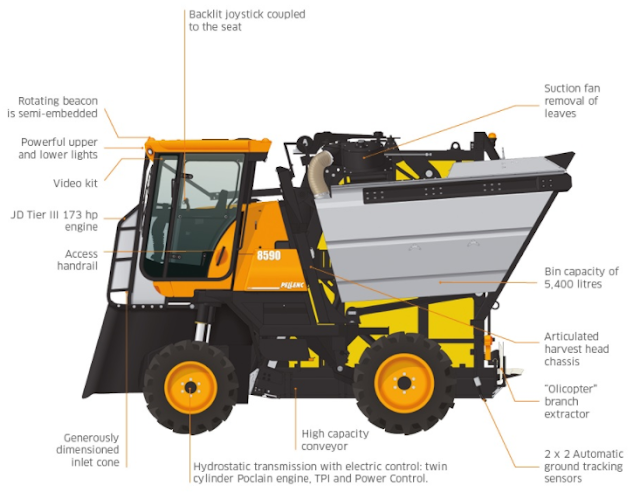11 – Harvesting and Storage
This week’s weblog covers everything related to the harvest of olives, whereby we will look into the equipment that is used, the characteristics of a ripe and unripe olive, and the optimum storage condition.
Figure 1: MAVO Olive Harvester (Pellenic, N.D.)
Harvesting
equipment
In the past one used
to beat olives out of the tree with a stick (King, 2010) . Now that most of
the production is done on a much larger scale, machines are designed that are intended
to make the harvest process easier and faster such as the Oxbo 6420 and the MAVO
olive harvester (Pellenic, N.D.) . What these machines
mainly do is vibrating the tree resulting in the olives to drop in a “bin”,
without damaging the tree. When the bin full the olives are transferred into a
much bigger container, ready to be processed. The MAVO olive harvester, for
example, is claimed to be PELLENC’s lightest carrier on the market with an
empty weight of 10.5 ton. Its driving speed goes up to 4 km/h and harvest yield
of 16 tons per hour, and got many other high tech gadgets, see figure 1.
Harvesting
time
Olives are said to be
pickled at any stage of ripeness (Olive Tree Growers, N.D.) . So are green ripe
olives picked when the juice inside turn from clear to milky. On the other
hand, black ripe olive either ripen on the tree or picked when they are green
and turned black when one process them. Therefore, unripe olives are green and
fully ripe olive are black (Warren, 2015) .
Over-ripe olive,
which are very soft and have a completely purple flesh, are said to yield more
oil (oil will taste either a bit bitter or not at all), in comparison to oil from unripe olive,
which will have a much reduced shelf life (York Olive Oil Co, N.D.) .
Optimal storage condition
Storing the olives at a proper temperature is important, because at low
temperature they will result in the browning of the skin and change in the
taste, and at high temperature they will rot (SEMCO, 2015) .
Therefore, the optimal temperature to store is said to be between 41°C and 50°C.
Additionally, the optimum humidity levels is about 90 to 95%, which will
prevent the olives from losing moisture and becoming dry. Finally, proper
ventilation is required, which prevent the air in becoming filled with carbon
dioxide resulting in running out of oxygen to take in.
References
King, A. (2010,
March 09). Picking Olives in Andalucia. Retrieved December 17, 2017,
from Inside The Travel Lab:
https://www.insidethetravellab.com/picking-olives/
Olive Tree
Growers. (N.D.). Frequently Asked Questions. Retrieved December 17,
2017, from Olive Tree Growers: http://olivetreegrowers.com/faq.php
Pellenic. (N.D.).
Olive harvesting head on Multifunction carrier. Retrieved December 17,
2017, from Pellenic: http://pellenc.com/agri/produits/mavo-olive-harvester/?lang=en
SEMCO. (2015,
November 01). COOLING AND STORAGE OPTIONS FOR OLIVES. Retrieved
December 17, 2017, from SEMCO:
http://semcoice.com/cooling/cooling-storage-options-olives/
Warren, P. (2015,
October 26). When to harvest olives and what to do with them. Retrieved
December 17, 2017, from Tuscon:
http://tucson.com/when-to-harvest-olives-and-what-to-do-with-them/article_7c74d63c-7c11-11e5-a9c3-6fc58d9317e3.html
York Olive Oil
Co. (N.D.). Knowing when to pick your olives. Retrieved December 17,
2017, from York Olive Oil Co:
https://www.yorkoliveoil.com.au/processing-your-olives/knowing-pick-olives/



Reacties
Een reactie posten